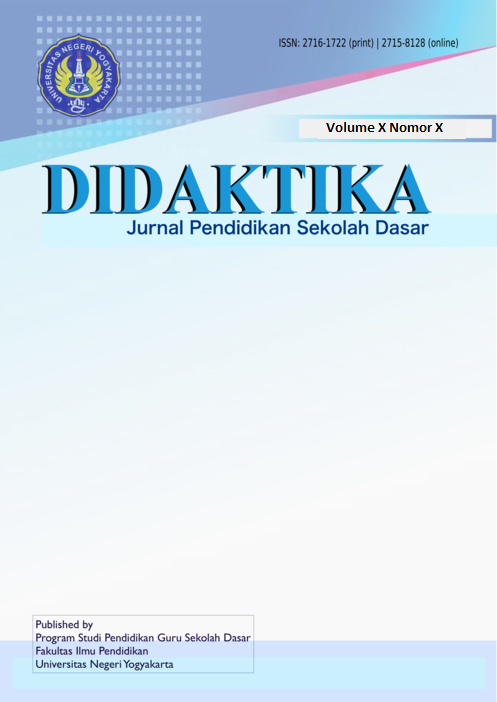Pengaruh Penggunaan Alat Peraga Timbangan Bilangan Terhadap Pemahaman Konsep Perkalian di Kelas II SD Islam Al Azhar 15 Pamulang
DOI:
https://doi.org/10.21831/didaktika.v1i1.27782Abstract
This study aims to know the use of numerical weighing tools against the suspension of mathematics concepts of students of class II Islamic El Al Azhar 15 Pamulang on multiplication materials. The numerical weighing tool is a semi-concrete tool or a machine that is working on an operation task. This research was conducted in the second grade of Al Azhar Islamic Elementary School 15 Pamulang. The method used in this research is quasi experimental method with The Nonequivalent Posttest-Only Control Group Design research design. The sample in this study consisted of an experimental class using 26 students and a control class directed by 26 students. Instrumen is used in this reseach such us mathematical conceptual ability written essay test. The results showed that the students used by using the instrument of numerical scales using the average ability to comprehend the concept of mathematics students is higher than the average ability to understand the concept of mathematics students who are taught without using the means of weighing the scale of the value of significance 0,001 0.05. Based on result of effect (effect size) obtained d value equal to 0,819. The value of the effect of the size obtained interprets that the use of numerical weights of numerals has a high category. Thus, this shows that there is an influence of the use of numerical weighing tools on the ability to understand the concept of mathematics students in class II Islamic Elementary School Al Azhar 15 Pamulang.
References
Becker, Lee A. "Effect Size (ES)", (http://web.uccs.edu/lbecker/Psy590/es.htm), 2000.
Djamarah, Syaiful Bahri. Psikologi Belajar. Jakarta: PT Rineka Cipta, 2002.
Hamalik, Oemar. Proses Belajar Mengajar. Jakarta: PT Bumi Aksara, 2011.
Ibrahim dan Suparni. Pembelajaran Matematika Teori dan Aplikasinya. Yogyakarta: Suka Press, Cet.1, 2012.
Lestrari, Karunia Eka dan Mokhammad Ridwan Yudhanegara, Penelitian Pendidikan Matematika. Bandung: PT Refika Aditama, 2015.
Suhartati, Representasi Geometris dari Bentuk Aljabar, Jurnal Peluang, Vol. 1, 2012.
Sumardi, Penggunaan Media Timbangan Bilangan Dalam Meningkatkan Hasil Belajar Matematika Operasi Perkalian Dan Pembagian Pada Siswa Kelas II SD, Skripsi diterbitkan Surakarta: Universitas Sebelas Maret Surakarta Surakarta, 2010.
Sundayana, Rostina. Media dan Alat Peraga dalam Pembelajaran Matematika. Bandung: Alfabeta, 2016.
Syafri, Fatrima Santri. Pembelajaran Matematika. Yogyakarta: Matematika, 2016.
Thalheimer, Will and Samantha Cook. How to calculate effect sizes from published research articles: A simplified methodology. A Work-Learning Research Publication, 2002.
Wafiqni, Nafia dan Asep Ediana Latip. Psikologi Perkembangan Anak UsiaMI/SD. Jakarta: UIN Press, cet.1 2015.
Downloads
Published
How to Cite
Issue
Section
License
- Authors retain copyright and grant the journal right of first publication with the work simultaneously licensed under a Creative Commons Attribution License that allows others to share the work with an acknowledgement of the work's authorship and initial publication in this journal.
- Authors are able to enter into separate, additional contractual arrangements for the non-exclusive distribution of the journal's published version of the work (e.g., post it to an institutional repository or publish it in a book), with an acknowledgement of its initial publication in this journal.
- Authors are permitted and encouraged to post their work online (e.g., in institutional repositories or on their website) prior to and during the submission process, as it can lead to productive exchanges, as well as earlier and greater citation of published work.






